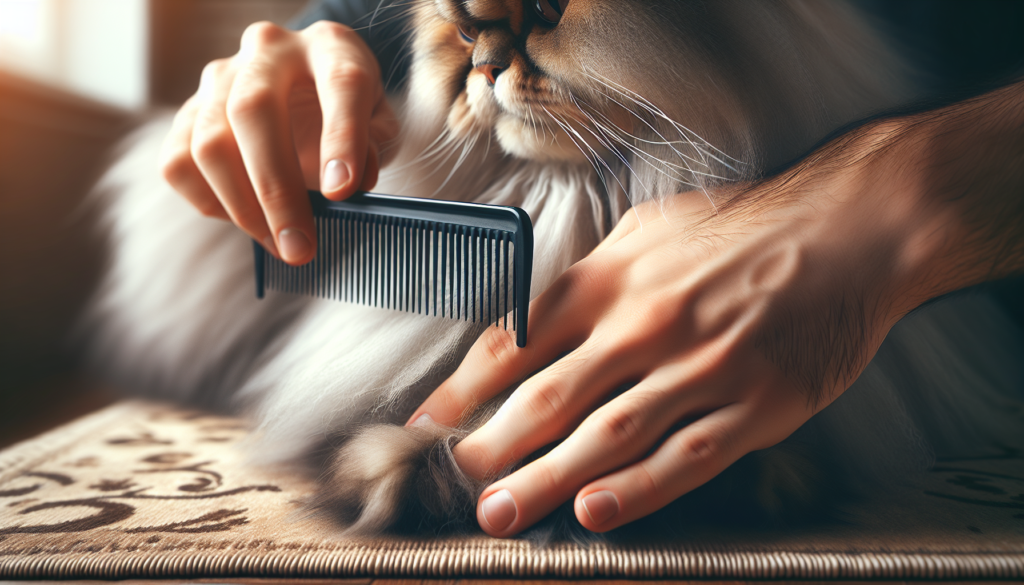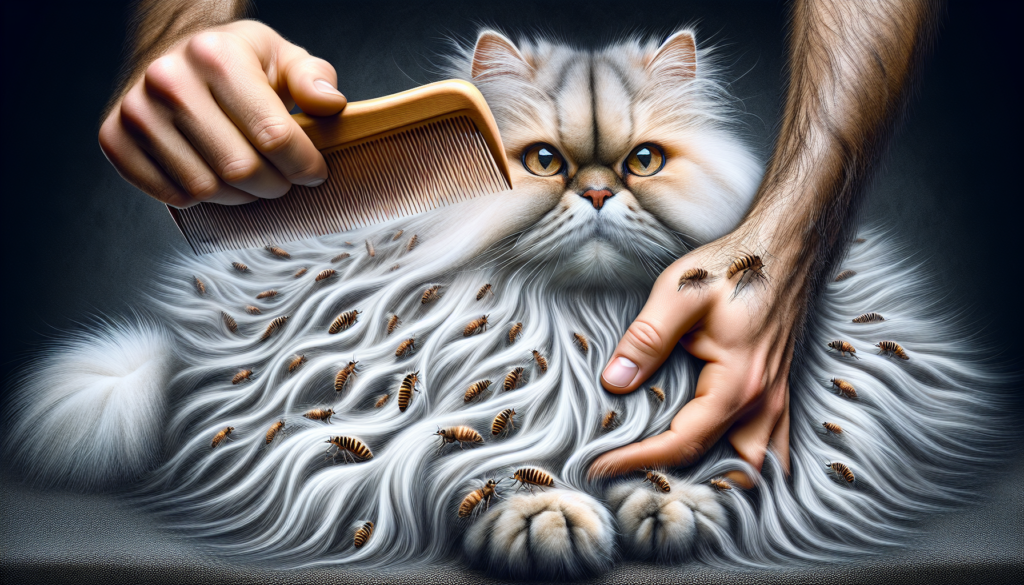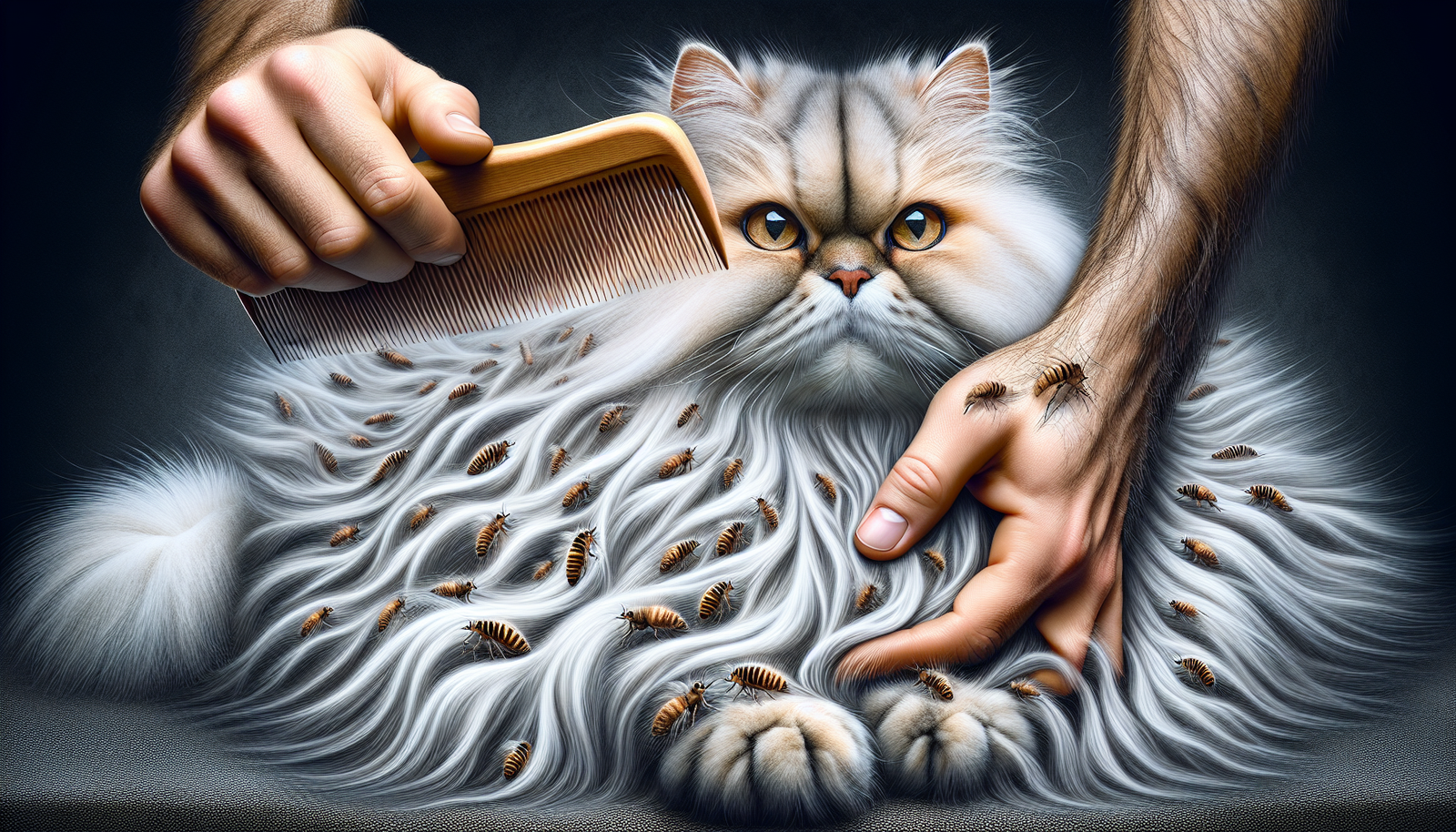Having a Persian cat is a delightful experience, but dealing with fleas can be a persistent problem. Don’t fret, as this article will provide you with effective methods to remove those pesky fleas from your beloved feline friend. From natural remedies to over-the-counter products, you’ll discover the best solutions to keep your Persian cat flea-free and happy. So say goodbye to scratching and hello to a peaceful and flea-free environment for your furry companion!
Identifying Fleas on Your Persian Cat
Signs of fleas on your Persian cat
To effectively remove fleas from your Persian cat, it is crucial to first identify the signs of infestation. Look out for the following indications that your cat may have fleas:
-
Frequent scratching and biting: If your cat is constantly scratching and biting at certain areas of their body, particularly around the neck, tail, and back, it may be a sign of flea activity.
-
Presence of small black or brown dots: Fleas leave behind their droppings, known as flea dirt, which appear as tiny black or brown specks on your cat’s fur.
-
Visible adult fleas: Sometimes, you may be able to actually see the fleas crawling in your cat’s fur. Fleas are small, brownish insects that are approximately the size of a sesame seed.
-
Red and irritated skin: Flea bites can cause allergic reactions in cats, leading to red, inflamed, or irritated skin. Keep an eye out for any unusual rashes or sores on your cat’s body.
The importance of early detection
Early detection of fleas on your Persian cat is crucial to prevent the infestation from spreading and causing discomfort to your pet. Fleas reproduce rapidly, and a few fleas can quickly turn into a full-blown infestation. By identifying the problem early on, you can take immediate steps to address it and prevent further escalation.
Consulting a veterinarian for confirmation
If you suspect that your Persian cat has fleas, it is always recommended to consult a veterinarian for confirmation. A vet can conduct a thorough examination of your cat’s fur and skin, and may use specialized tools such as a flea comb to look for signs of fleas. Once the presence of fleas is confirmed, your veterinarian can guide you on the most appropriate treatment options for your cat’s specific needs.
Preventative Measures for Flea Control
Regular grooming and bathing
Regular grooming and bathing are essential for maintaining a healthy and flea-free coat for your Persian cat. Brushing your cat’s fur helps to remove any fleas or flea dirt that may be present, while bathing with a cat-friendly flea shampoo can effectively drown and eliminate adult fleas.
Using flea combs to remove adult fleas
Flea combs are specially designed with fine teeth that can capture and remove adult fleas from your cat’s fur. Comb your cat’s coat meticulously, paying attention to areas where fleas tend to hide, such as the base of the tail and the neck. Dip the comb in soapy water after each stroke to drown any fleas you have captured.
Applying topical flea preventatives
Topical flea preventatives, such as spot-on treatments, are commonly used to protect cats from fleas. These treatments are applied directly onto the skin, usually between the shoulder blades, and spread throughout the body, providing long-lasting protection against fleas. Make sure to choose a product specifically formulated for cats, as some flea preventatives for dogs can be toxic to cats.
Oral flea control medications
Oral flea control medications are another option for preventing flea infestations in your Persian cat. These medications come in the form of pills or chewable tablets and are typically administered once a month. They work by interrupting the flea life cycle by killing adult fleas and preventing the development of flea eggs and larvae.
Sprays and powders for flea prevention
There are also flea prevention sprays and powders available that can be used on your Persian cat. These products contain insecticides that kill adult fleas on contact. When using sprays or powders, ensure you follow the instructions carefully and avoid getting the product in your cat’s eyes or mouth.

Home Environment and Flea Prevention
Vacuuming and cleaning regularly
Keeping your home clean and free from flea eggs and larvae is crucial in preventing re-infestation. Vacuum your floors, carpets, and upholstery regularly, paying extra attention to areas where your cat spends most of their time. Dispose of the vacuum bag or empty the canister outside to prevent fleas from re-infesting your home.
Washing bedding and blankets
Flea eggs and larvae can also be present on your cat’s bedding and blankets. To eliminate them, wash these items in hot water with a cat-safe detergent. High temperatures will kill any fleas and their eggs, ensuring that your cat’s sleeping areas remain flea-free.
Treating carpets and upholstery with flea spray
Flea sprays specifically designed for treating carpets and upholstery can be an effective method of flea prevention in your home. Prior to using any products, be sure to check if they are safe for use around pets. Follow the instructions on the product label and apply the spray evenly, focusing on areas where your cat spends the most time.
Maintaining a flea-free yard
Fleas can also be present in your yard, so it is important to take measures to keep your outdoor space flea-free. Keep your lawn well-trimmed, as fleas prefer shady areas with tall grass. Regularly inspect outdoor hiding spots, such as mulch beds and under decks, and consider using pet-safe yard sprays or nematodes to control flea populations.
Natural and Organic Flea Remedies
Herbal flea collars and necklaces
Herbal flea collars and necklaces can provide a natural alternative to traditional flea control methods. These products are infused with essential oils or herbal extracts that repel fleas. However, it is important to choose collars and necklaces that are specifically designed for cats, as some ingredients may be toxic to felines.
Essential oils for flea control
Certain essential oils, such as lavender, citronella, and lemongrass, are known to have flea-repellent properties. Dilute a few drops of the essential oil in water and spray it onto your cat’s fur, avoiding contact with their eyes and mouth. It is important to note that some essential oils can be toxic to cats, so always research the safety of the oil before using it.
Homemade flea repellent sprays
You can also create your own natural flea repellent sprays using ingredients found in your kitchen. A mixture of equal parts water and apple cider vinegar can be sprayed onto your cat’s fur to repel fleas. Another option is a lemon-infused spray, which can be made by boiling sliced lemons in water and allowing it to cool before applying it to your cat’s coat.
Diatomaceous earth as a non-toxic option
Diatomaceous earth, a fine powder made from fossilized algae, is a non-toxic option for flea control. Sprinkle a small amount of food-grade diatomaceous earth onto your cat’s fur and gently massage it in. The powder dehydrates and kills adult fleas, making it an effective natural remedy. Be cautious not to inhale the powder, as it can be irritating to the lungs.

Treating Flea Infestation on Your Persian Cat
Consulting a veterinarian for treatment options
If your Persian cat is already suffering from a flea infestation, it is essential to consult a veterinarian for appropriate treatment options. A vet can determine the severity of the infestation and recommend the most effective course of action to eliminate the fleas.
Using flea shampoos and dips
Flea shampoos and dips are medicated products designed to kill and repel fleas on contact. Bathe your cat using a flea shampoo specifically formulated for felines, massaging it into their fur and leaving it on for the recommended duration before rinsing thoroughly. Flea dips can be an alternative option for cats that are not comfortable with baths.
Prescription flea medications
In severe cases or cases of recurring infestations, your veterinarian may prescribe prescription flea medications for your Persian cat. These medications are typically stronger and more effective than over-the-counter products, providing targeted treatment for the specific needs of your cat.
Flea foggers and sprays for the household
To eliminate fleas from your home and prevent re-infestation, consider using flea foggers or sprays specifically designed for household use. Follow the instructions carefully, ensuring that all family members and pets are safely out of the treated area during and after application. These products can help target fleas hiding in cracks, crevices, and carpets.
Professional exterminators for severe infestations
In cases of severe infestations or persistent flea problems, it may be necessary to seek the assistance of professional exterminators. These experts have the knowledge and equipment to effectively eradicate fleas from your home and prevent future infestations. Consult with a reputable pest control company to assess the severity of the problem and explore your options.
Dealing with Fleas in Multi-Pet Homes
Treating all pets simultaneously
If you have multiple pets in your household, it is crucial to treat all of them for fleas simultaneously, even if only one pet shows signs of infestation. Fleas can easily transfer between animals, so treating all pets will help prevent the infestation from spreading or recurring.
Separating infested pets from non-infested ones
While treating all pets simultaneously is important, it may be necessary to temporarily separate infested pets from non-infested ones to prevent the spread of fleas. If possible, keep the infested pet in a separate area with minimal contact with other animals until the infestation is under control.
Cleaning and treating the entire household
Fleas can quickly reproduce and spread throughout your entire household, so it is essential to thoroughly clean and treat your home to eliminate any hidden flea eggs or larvae. Follow the same cleaning and prevention methods mentioned earlier to ensure all areas are flea-free.
Preventing re-infestation among pets
To prevent re-infestation among your pets, continue with regular flea prevention treatments even after the infestation has been resolved. Consistently using flea preventatives tailored for each pet’s needs will help protect your furry companions and maintain a flea-free environment.
Persistent Flea Problems and Seeking Veterinary Help
Recognizing potential complications
In some cases, flea infestations can cause complications for your Persian cat, such as severe itching, skin infections, or allergic reactions. If you notice any unusual symptoms or if your cat’s condition worsens despite treatment, it is important to seek veterinary help promptly to address any potential complications.
Effectiveness of over-the-counter treatments
While over-the-counter flea treatments can be effective for many cases, they may not always provide sufficient control for severe infestations or when dealing with resistant fleas. If you have tried multiple over-the-counter products without success, consulting a veterinarian for stronger prescription treatments may be necessary.
Specific prescription treatments for resistant fleas
Some fleas may develop resistance to certain types of treatments, making them more difficult to eliminate. In such cases, a veterinarian can prescribe specific flea treatments that are known to be effective against resistant flea populations. These treatments may include different types of medications or alternative forms of flea control.
Consulting a veterinarian for further advice
If you are facing persistent flea problems despite your best efforts, it is advisable to consult a veterinarian for further advice. They can assess your specific situation, provide guidance on alternative treatments or prevention methods, and offer support to address any ongoing issues.
Common Mistakes to Avoid in Flea Removal
Using dog-specific flea products on cats
Cats are highly sensitive to certain chemicals found in flea products designed for dogs. Using dog-specific flea treatments on your Persian cat can result in severe toxicity and, in some cases, even be fatal. Always read the labels carefully and use products specifically formulated for cats.
Missing regular flea prevention treatments
Consistency is key when it comes to flea prevention. Missing regular treatments increases the risk of infestation and may render previous efforts ineffective. Set reminders or follow a schedule to ensure you stay on top of your cat’s flea prevention regimen.
Neglecting the home environment in flea control
Focusing solely on treating your Persian cat without addressing the flea problem in your home can result in continuous re-infestations. Fleas can hide in various areas of your home, so it is essential to include thorough cleaning and preventive measures in your flea control strategy.
Overusing or misusing flea medications
Using more flea medication than prescribed or applying it too frequently can have adverse effects on your Persian cat’s health. Always follow the instructions provided by the manufacturer or your veterinarian to ensure the safety and effectiveness of the flea treatment.
Preventative Measures for Future Flea Infestations
Continuing regular grooming and bathing
Maintain a regular grooming and bathing routine for your Persian cat to keep their coat healthy and free of fleas. Regular inspections and care will help you detect any signs of fleas early on, allowing for prompt action.
Consistent use of flea preventatives
Continue using flea preventatives as recommended by your veterinarian to prevent future infestations. Consistency is key in combating fleas, so adhere to the recommended treatment schedule and follow any additional instructions provided by your vet.
Maintaining a clean and flea-free environment
A clean environment plays a significant role in preventing flea infestations. Regularly vacuuming, cleaning, and treating your home will help minimize the risk of fleas and provide a safe environment for your Persian cat.
Monitoring your Persian cat for signs of fleas
Even with preventative measures in place, it is essential to stay vigilant and monitor your Persian cat for any signs of fleas. Regularly check for flea dirt, monitor their behavior and grooming habits, and seek veterinary advice at the first sign of any potential flea problem.
Conclusion
Identifying and effectively removing fleas from your Persian cat requires a comprehensive approach that includes early detection, preventative measures, and proper treatment. By being proactive in flea control and working closely with your veterinarian, you can ensure a flea-free and comfortable environment for your beloved Persian cat. Remember to use cat-specific flea products, maintain a clean home, and continue regular grooming and preventative treatments to safeguard your cat against future flea infestations.

